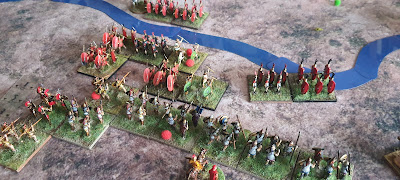I have mentioned the virtues of contrast paints in the past, but noted yesterday that I was able to paint 5 figures in about 15 minutes...
 |
| The central command figure is Valiant miniatures - a little bigger, but takes contrast paints so well - the others are Revell that I have not been inspired to paint for 20 years. |
Now I had previously sprayed these a 'mustardy tan' (the army painter sand colour) - the undercoat very much being the key to contrast paint, and I used GW contrasts (see, they are good for something) and Army Painter speed paint.
 |
| This is all 'one' coat bar the webbing. I get highlights, detail on the flesh (check the fingers), and an overall finished impression. |
I have experimented with white, off white, and mustardy tan as undercoats, and the results are always good depending on what you want. Sword n Sorcery style figures seem to benefit from the pure white undercoat.
Now I have never been a painter of quality (uhh painting specifically that is; I am of course the veritable gentleman)- I want the troops on the table, and patience for 'serious' painting has always eluded me, but this method really works for me.
The contrast paint forms a dark tone, base colour and highlight in one hit. Now granted, for these British infantry I did use a little acrylic to highlight the webbing, but the time factor was the main thing...outstanding results, and more than enough for the 'two-foot rule', once the younger eyesight has gone.
In other news, have lifted 'Field of Battle ww2' which used to be a house fave for larger battles - where a base is a company, and a maneuver unit a battalion.
 | |
| 'Do you mean Clare-MON'T' Brooker???' |
Now, this uses cards, and as those I used before are a little drab, I opted to make some for myself on menu cardstock...incorporating great ww2 Hollywood movies where practical...and WW2 pics where possible.
 | |
| The Kelly's Heroes Morale card still makes me laugh |
(It should be noted that most of the actors/actresses in these pics are dead now. RIP.)
 |
| Woof woof! |
 |
| Ingrid Pitt, Mary Ure, Clint Eastwood and Richard Burton in the absolute classic 'Where Eagles Dare'. Sadly, only Clint is still alive. |
 |
| 'It's a mother beautiful bridge, and it's gonna be there...' |
Looking forward to these seeing some action.
...accompanied by the single best war movie theme ever written...
...although this one is a close second...



















































